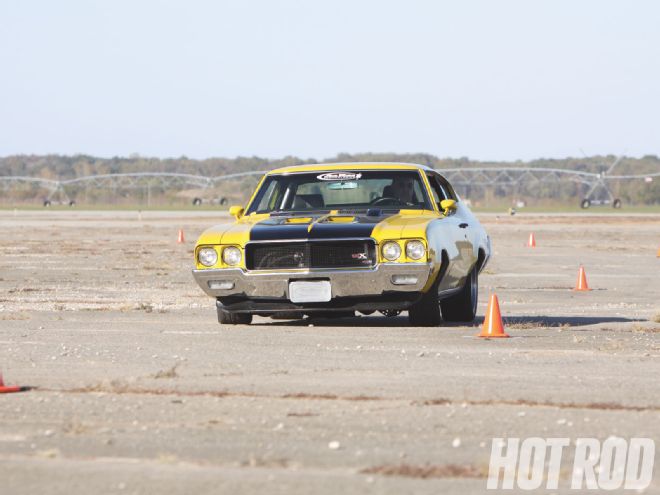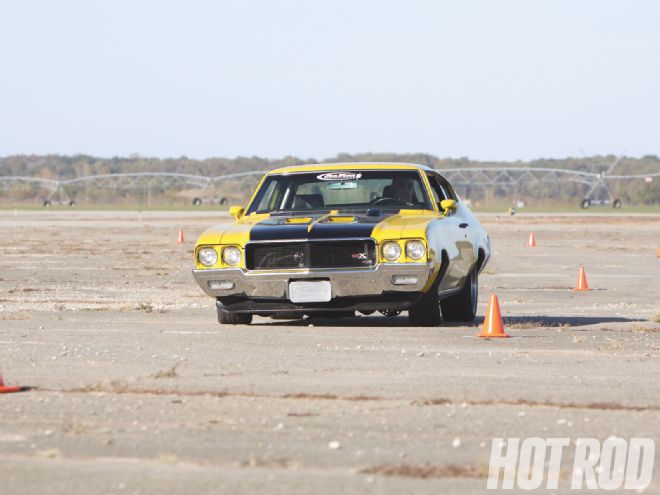
Ever wonder how a manufacturer builds a shock to elicit a great ride and handling characteristics when it's installed into a specific car? We assume lots of road testing is the key. RideTech showed us that was just part of the equation. The secret to its shock development comes from road testing, sure, but the company also employs a system developed by NASA that measures the frequency of movement felt by astronauts during space shuttle launches. A variant of that device now helps RideTech improve the valving of its shocks. The ride meter is a small box placed on the floor of a hot rod directly beneath the driver seat, and the data it records during a road test provides instant feedback that can turn into a smoother ride and faster lap times on the racetrack.
 Our test car was a Pro Touring-style '70 Buick GSX powered by a TA Performance Stage 1 455 that pumps out 538 hp. We beat on this thing mercilessly, and the fuel-injected powerplant never whimpered. A beltdriven oil pump, a big PRC aluminum radiator with dual 11-inch fans, and a huge fuel tank with a generous sump made the Buick the perfect corner-carving test car. The engine spins a ZF six-speed hooked to a Moser 12-bolt with an Eaton TrueTrac and 4.11s. Stopping power comes from Wilwood discs and calipers, and the GSX rides on a complete RideTech Street Challenge air suspension system that includes tubular control arms and sway bars.
Our test car was a Pro Touring-style '70 Buick GSX powered by a TA Performance Stage 1 455 that pumps out 538 hp. We beat on this thing mercilessly, and the fuel-injected powerplant never whimpered. A beltdriven oil pump, a big PRC aluminum radiator with dual 11-inch fans, and a huge fuel tank with a generous sump made the Buick the perfect corner-carving test car. The engine spins a ZF six-speed hooked to a Moser 12-bolt with an Eaton TrueTrac and 4.11s. Stopping power comes from Wilwood discs and calipers, and the GSX rides on a complete RideTech Street Challenge air suspension system that includes tubular control arms and sway bars.
During the late '70s and early '80s, NASA subjected astronauts to a barrage of tests inside a roller coaster-type simulator. The simulator shook at frequencies ranging from 0 to 40 Hz (which is all you typically see in an automobile on the street) with incremental changes and then asked the test subjects to report which frequencies made them feel ill or uncomfortable. An algorithm was created using this feedback, and it has been modified over the last 25 years and applied to OEM auto design as part of vehicle suspension development procedures that prevent passengers from barfing their brains out when running over potholes in new cars.
The recorded data consists of input from several linear accelerometers built into the ride meter. One measures the vertical motion of the car, another keeps tabs on the horizontal positioning, and another measures any change in lateral direction. There are also two rotational accelerometers, one measuring pitch and the other roll. The box is active as the car is driven over a measured stretch of road that tests the car's suspension. Once the accelerometer data is recorded, software converts each data group (by accelerometer) to the frequency domain to apply the NASA algorithm. The result is five distinct ride numbers, one for each axis of vehicle movement, that add up to the vehicle's total ride number. The lower the number the better the car purportedly rides.
RideTech offered HOT ROD an inside look at the testing it conducts to develop shock-valving parameters for its ShockWave air spring products using the ride meter. We rode along in the company's in-house Buick GSX test car during road testing and also made a ton of laps on an autocross track to see if RideTech's more expensive adjustable shocks work better than the cheaper ones. Because the conditions weren't controlled, and because we didn't have a professional driver behind the wheel, the lap times don't reveal much other than it's possible to go fast with all the shocks we tested. But the data the ride meter gave us put into perspective the differences in shock design as we beat on the Buick with every shock in the RideTech arsenal, as well as a pair of competing coilovers.
The short story is we found that all the shocks tested are suitable for the average street car that sees the occasional track day. Those of you who spend more effort chasing lap times than trophies will want to opt for the adjustable units. At the end of the day, your wallet, performance goals, and ego will likely dictate which shocks you purchase. But at least you know that any of these shocks will work well. You just have to decide if you want to make adjustments by crawling under your car, pushing a button, or not at all. And if the smoothest ride is your goal, you win, because you get to buy the least expensive stuff.
DAMPER TYPE LAP 1 LAP 2 LAP 3 AVERAGE LAP TIME PRICE (PER PAIR) RideTech Black Series 50.445 50.755 51.084 50.761 $599.00 RideTech Master Series DA 50.629 49.375 50.909 50.304 $900.00 RideTech Select Series (soft setting) 49.254 49.503 52.305 50.354 $1,200.00 RideTech Select Series (firm setting) 49.827 49.866Lap times are a good indicator of a car's performance, but we must remember that there's still a human behind the wheel and there are many variables that can influence how quickly a car goes around the track. Consistency is not easy to achieve, and the relatively short duration of our test course will not highlight the tendency of more expensive monotube shock designs to maintain their performance over a longer period of time versus twin-tube designs.